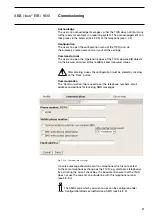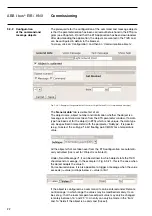
10
ABB i-bus
®
EIB / KNX
Depending on the type of object, you can view the current states of the
objects (e.g. the ‘Alarm’ is not active) or issue commands. It is possible for
example in the case of the ‘Light Ground Floor’ object to switch the light on
or off.
All the alarms that have occurred are displayed on this page.
The status indicates whether
• the alarm is still active (red)
• the alarm has been acknowledged or is no longer active (yellow)
• the alarm has been acknowledged and is no longer active (green).
The alarm text is issued in the ‘Message’ column. The start time and stop
time indicate when the alarm arrived or left. A red dot appears in the
‘Acknowledged’ column if the alarm has not yet been acknowledged.
Once the acknowledgement has been carried out, the date and time of the
acknowledgement are entered together with the name of the user
who acknowledged the alarm.
To acknowledge an active alarm, click on the red button in the
‘State’ column. The button then changes its colour from red to yellow
and the date and time of the acknowledgement are entered
in the ‘Acknowledged’ column together with the name of the user
who acknowledged the alarm.
Up to 1000 alarms can be stored in the alarm history. The alarm memory
is based on the FIFO principle i.e. if there are more than 1000 alarms,
the oldest one is deleted and a new one is accepted.
This page displays the most current system states i.e. an EIB error or a fault
with the telephone connection.
4.3.2 ‘Alarms’ page
4.3.3 ‘System’ page
Function and Operation













































